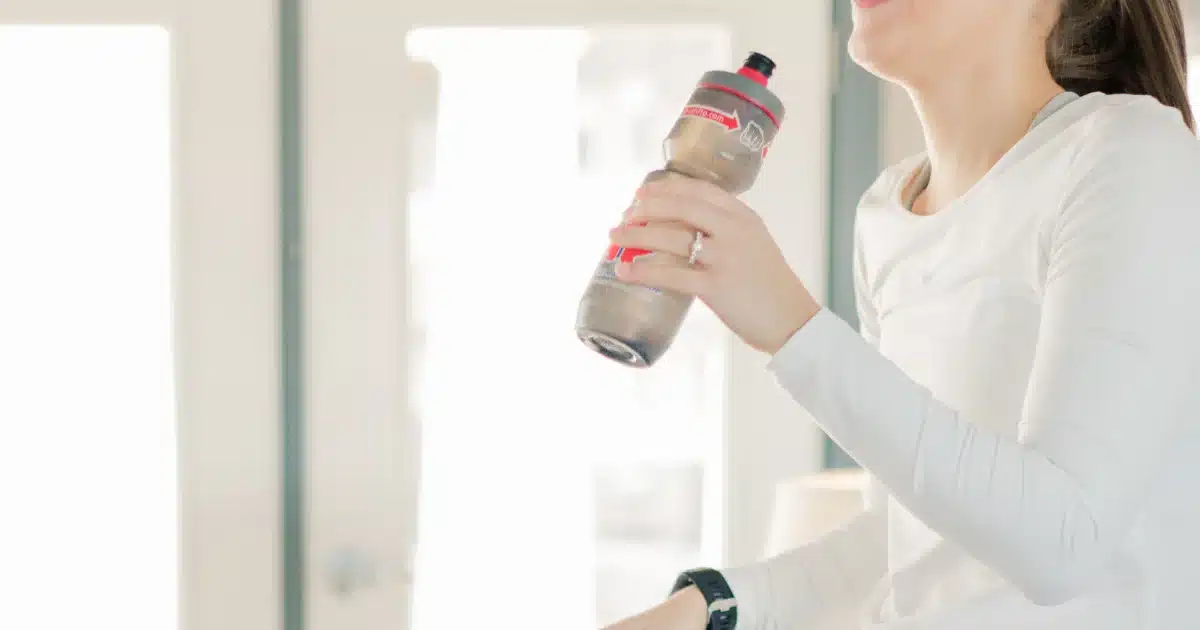Level Up Your Nutrition Game With Our Freebies
Alex
I provide nutrition coaching for endurance athletes to improve performance and body composition through a simple and flexible eating style.
Hi, I'm
ATHLETE EATING GUIDE →
LEARN MORE →
ATHLETE GROCERY SHOPPING GUIDE →
10-DAY PROTEIN-PACKED SAMPLE MEAL PLAN
READY TO FUEL?
incredible value!
The fueling guide bundle serves as your one-stop-shop for strategies to fueling before, during and after your workouts.

Hydration is essential for athletes, and dehydration can occur at any time in any climate. Even the smallest amount of dehydration can negatively impact athletic performance. Use these practical hydration guidelines for athletes to support your biggest performance goals.
How important hydration is for athletes
Your body is made up of around 60% water. These levels, also known as your hydration status, fluctuate throughout the day as you lose and gain water. You can lose water through sweat, breathing, and an increase in core body temperature. As you can probably guess, you gain water through drinking, eating, and other metabolic processes.
Maintaining proper hydration before, during, and after your training is extremely important. As athletes, you are exerting more energy through movement and likely producing more sweat. This sweat loss can lead to a faster and greater risk of dehydration during events and training sessions.
If you want to be able to perform to the best of your ability, it is in your best interest to prioritize your hydration. This may look like keeping hydration mixes in your belt, having an extra water bottle on-hand, and calculating your sweat rate to determine your average water loss.
Effects of hydration on sports performance

Being able to understand and assess your hydration is critical as an athlete. Proper hydration can prevent injury and illness, speed up recovery, and enhance overall performance. On the flip side, dehydration can occur when an athlete loses more water than they are consuming.
Especially in hot and humid conditions, or during prolonged exercise (>90 minutes), athletes can lose water at a rapid rate. If you aren’t actively replenishing with water and electrolytes, dehydration can creep up faster than you’d think.
So how does this affect sports performance? Well, we know that dehydration of even a 2% water loss can impair an endurance athlete’s performance. This is due to a variety of reasons, one being a decrease in blood volume and blood flow. With a lack of water, your blood starts to thicken and reduces its ability to transport nutrients and oxygen to your other cells.
Benefits of hydration for athletes
A dehydrated athlete will not perform to the best of their ability. Science has shown us that staying hydrated can have many overall benefits for athletes.
Benefits of hydration for athletes include:
- Reduce fluid loss
- Improve cardiovascular outcomes such as a decrease in heart rate and maintaining blood volume
- Delay the onset of fatigue
- Prevent dehydration-associated injuries
- Less risk of heat stroke, stress, or illness
Additionally, hydration can be beneficial for other aspects of your health:
- Improve sleep quality
- Better mood and cognition
- Prevent infections and illnesses
- Lubricate joints
- Keep organs functioning properly
Now that you know the impact that staying hydrated can have on your performance and health, keep reading to learn more about when and how athletes should hydrate.
When should athletes hydrate?
The timing of your hydration is a key component of your overall status. When you should hydrate will depend on the duration of your session and the intensity or type of training you are performing. A bit of advanced planning is helpful so that you can hold yourself accountable for keeping hydrated.
Practical hydration guidelines for athletes around training sessions include:
- Consume ~500 mL of fluids 1-2 hours before your session
- Continue to consume cool/cold liquids during your event
- For prolonged exercise lasting >60 minutes, athletes should drink 600-1200 mL of fluids intra-workout
To meet your daily water intake you should also be drinking periodically throughout the day when you aren’t training (aka in recovery). A great starting point is to get into the practice of drinking 4-8 oz (120-240 mL) of water every 15-20 minutes.
What are the best fluids for athletes to drink?

Most of the time plain water will be your go-to drink for hydration throughout the day. In and around your training sessions, there can be additional benefits to adding elements to your water such as electrolyte and hydration mixes and drinking sports drinks.
I’m a big fan of hydration mixes. They’re a powder mix that offers carbs, sugar, and electrolytes. A 3-in-1! The sugar and carbs provide on-the-go fuel and they typically contain a good amount of electrolytes to help you replenish the sodium lost through sweat.
Electrolyte mixes are also a great option. If you haven’t already, make sure to check out my full article on electrolytes for endurance athletes! I do a full comparison of some of the top electrolyte mixes and brands.
How much water should an athlete drink per day?
It is impossible to develop one-size-fits-all fluid and electrolyte guidelines due to the multiple factors that influence sweat rates and sweat electrolyte losses.
General guidelines for athletes for total water intake daily are:
- According to the National Academy of Sports Medicine, the recommended fluid intake for men is 125-130 oz/day (approx. 16 cups) and 91-95 oz/day (approx. 12 cups) for women
Remember that this number can increase depending on your training duration and intensity.
It is recommended to perform a sweat test to get an idea of your sweat loss rate. See the subheading below for how to calculate your sweat rate.
Action step: start tracking your water intake in an app or journal over the course of a few days and training sessions. This will give you a good starting point to go off of.
Can athletes drink too much water?
Did you know that athletes can also drink too much water? Yes- that’s right. While you want to be hydrated, you don’t want to overload your body with excess water. Especially plain water that hasn’t been enhanced with electrolytes.
An over-dilution of water without electrolytes can lead to a condition called hyponatremia. Hyponatremia is characterized by having below-normal levels of sodium in your blood (<135mmol/L). So don’t make the mistake of chugging water without considering your electrolyte levels!
Calculate your sweat rate

A method to determining how much fluid you need to drink during a workout is by measuring your sweat rate. Sweat rate is typically higher in men and in those that are at a high level of physical fitness.
Calculating your sweat rate is actually quite easy, it just requires some planning. I’d also recommend checking your sweat rate in different temperatures and seasons. Your sweat rate can also change as you increase your physical fitness, or after 10-14 days of heat exposure due to your body acclimating to the heat. Knowing how it varies can also help you prepare for race day. Looking at the weather forecast and your average sweat rate for that type of weather will give you a better idea of how much fluids you need to be taking each hour to keep up your hydration levels.
To accurately measure your sweat rate, you’ll want to follow this procedure:
- Warm up to the point that you just begin to sweat.
- Urinate, if needed.
- Using an accurate scale, weigh yourself. Weighing yourself nude is the best practice.
- Work out for a specific time. A one-hour workout is the easiest to calculate sweat rate per hour.
- Do not urinate during the workout.
- Drink a measured amount of fluids during the workout.
- Weigh yourself again. Using the same scale that you used prior to the workout, and wearing exactly the same clothing (or lack of clothing if you chose to weigh nude).
- Enter your data into my free downloadable Sweat Rate Calculation form to calculate your average sweat rate.
Like I said, it takes some planning but this type of prep work can be so helpful in planning your hydration plan for competition.
The Takeaway
Don’t let your performance take a hit because your hydration levels aren’t adequate. It could be the difference between shaving a few minutes off your best time or preventing an injury from occurring.
Are you looking for additional guidance for fueling pre, intra, and post-workout? Then my athlete fueling guides are right for you!
These digital downloads include tangible tips from sports dietitians on how to optimize your fueling as an endurance athlete. You can purchase them separately or buy the bundle of all three to get the best deal!
Alex
I provide nutrition coaching for endurance athletes to improve performance and body composition through a simple and flexible eating style.
Hi, I'm
LEARN MORE →
take the quiz!
Let's discover your Endurance Nutrition IQ
How well do you know your fueling? Answer these questions and let's see where your endurance nutrition knowledge is at!
Take the quiz
level up your nutrition game with these freebies
free downloadS
Protein-Packed 10-Day Sample Meal Plan
Athlete Eating Guide
Athlete Grocery Shopping Guide
1
2
3
Inspiration to fit 120 grams of protein into your day
Planning what goes on your plate
Putting the right foods in your grocery cart
